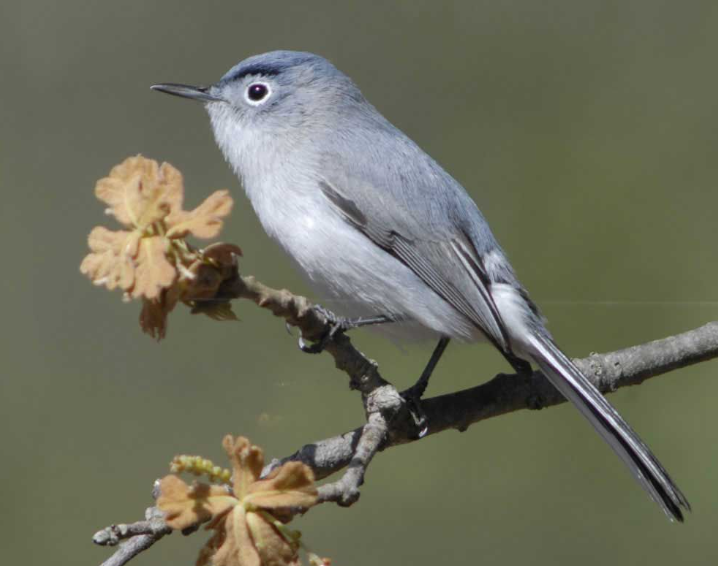
Small size, blue-gray plumage, and distinctive long tail
The little bird known as the Blue Grey Gnatcatcher is found throughout North America. It may be identified by its distinctive blue-gray plumage and long, thin tail. This bird is small, measuring around 4.5 inches in length and 0.3 ounces in weight. Despite its small size, the Blue Grey Gnatcatcher is a restless and quick bird that often darts about in search of insects to eat.
Blue-Gray Gnatcatcher bird and its significance in the avian world
One interesting feature of the Blue Grey Gnatcatcher is its unique way of foraging. It is said to hover in midair, like a hummingbird, and gather insects on its wings. Its inclination allows it to swiftly and accurately pick insects out of the air. When constructing its nest, the Blue Grey Gnatcatcher is also known to use spider silk to blend in with the tree branches.
Distribution across North and Central America, including specific regions or countries
The blue-grey gnatcatcher is a migratory bird that spends its breeding season in North America before migrating to Central America or the Caribbean in the winter. During the mating season, the male Blue Grey Gnatcatcher participates in intricate courtship displays to woo a mate. These displays are often carried out by the male by fluffing up its feathers, spreading its tail, and singing a challenging song. The female Blue Grey Gnatcatcher selects a mate based on the male’s ability to provide for her and their offspring after these displays.
Fascinating facts about Blue-Gray Gnatcatcher Bird
North and Central America are home to the little, insectivorous Blue Grey Gnatcatcher bird. Birdwatchers and wildlife lovers love this bird for its unique blue-grey coloration and energetic activity. Below is some fascinating information about the Blue Grey Gnatcatcher, including:
Physical appearance of the Blue Gray Gnatcatcher bird
The Blue Grey Gnatcatcher is a little bird, barely a few grammes in weight and around 4.5 inches in length. Its upper body is blue-grey, its underbelly is white, and its tail is long, narrow, and black. The male bird’s blue-grey colouring is somewhat darker than the female’s, although both birds have comparable appearances.
Preferred habitats of the Blue Gray Gnatcatcher bird, such as woodlands, forests, or shrubby areas
These birds like living in shrubby habitats, mixed woods, and deciduous forests. They are also seen in heavily vegetated parks and gardens. The Blue Grey Gnatcatcher is renowned for its skill in navigating through thick vegetation by using its long tail as a balance aid.

Foraging techniques, such as gleaning insects from foliage or catching them mid-air
A bird of great agility and activity is the blue-grey gnatcatcher. It is always moving, darting from branch to branch in its quest for insects. It is well-known for its unusual “gnat-catching” habit, in which it catches insects on the wing by hovering in midair. The bird gets its name from this habit.
Behaviour of the Blue Gray Gnatcatcher bird, including its active and energetic nature
Because they are insectivores, Blue Grey Gnatcatchers mostly consume tiny insects like beetles, flies, and mosquitoes. They’ve also been seen to consume caterpillars and spiders. They fly quickly and perform acrobatic flights during their foraging activities, searching among leaves and branches for prey.
Breeding habits of the Blue Gray Gnatcatcher bird, including its monogamous nature
In most cases, Blue Grey Gnatcatchers breed from April through July. They use lichens, plant fibres, and spider silk to construct tiny, cup-shaped nests. These nests are often concealed by bushes and trees’ foliage. The female spends around two weeks incubating her three to five eggs. Until the hatchlings fly, both parents alternately feed them.
Unique vocalisations of the Blue Gray Gnatcatcher bird
The vocalisations of the Blue Grey Gnatcatcher are renowned for being intricate and diverse. It calls with a nasal, high-pitched sound that resembles a gentle “tsee.” In order to entice a mate and protect its territory, the male sings a sequence of fast, high-pitched notes throughout the breeding season. All day long, one may hear these tunes.
Migration patterns of the Blue Gray Gnatcatcher bird
Birds that migrate are blue-grey gnatcatchers. They travel to regions of Mexico, Central America, and the southern United States throughout the winter. In the spring, they migrate back to North America, where they reproduce. Food availability and the suitability of nesting locations affect their movement patterns.
Information on the conservation status of the Blue Gray Gnatcatcher bird
As of right now, the Blue Grey Gnatcatcher is not considered a threatened species. However, their population faces serious problems because of habitat loss and fragmentation. The major goals of conservation initiatives are to protect and restore the animals’ preferred habitats, which include protecting old forests and establishing migratory routes.

Interesting facts about this unique bird: Blue-Gray Gnatcatcher Bird
The unique coloration, lively activity, and small size of the Blue Grey Gnatcatcher make it an intriguing bird to watch. It is an amazing creature to see because of its capacity to fly, collect insects on the wing, and manoeuvre through thick vegetation. We can grasp the significance of protecting these birds’ habitats and guaranteeing their continued existence by learning more about them.